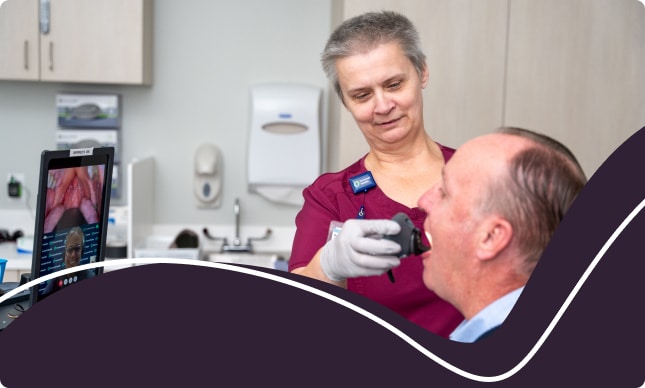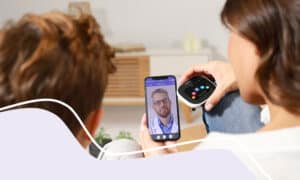Urgent Care, Smarter Tools: How Virtual Exams Are Improving First-Line Response

In a world where healthcare needs can’t wait, urgent care is stepping up—and so are the tools that support it. In this post, we’ll explore how urgent care is evolving, how virtual exams and connected technology are helping, and what this means for patients and clinics alike.
The Changing Face of Urgent Care
Urgent care clinics have become a major part of the healthcare landscape. The Urgent Care Association (UCA) estimates there were over 15,000 urgent care centers in the U.S. as of January 2025.
In 2022 alone, urgent care centers treated almost 206 million non-emergency cases, while U.S. emergency departments saw about 131 million visits.
Due to this role, urgent care is increasingly becoming the “front door” of healthcare, where many people turn when they need help quickly. But being the front door comes with challenges.
Urgent Care Under Pressure: The Challenges Facing First-Line Services
Here are key pressures urgent care clinics face:
Rising Utilization
- In 2019, about 29.2% of U.S. adults had visited an urgent care or retail health clinic in the previous 12 months.
- From 2019 to 2023, non-COVID commercial urgent care volumes increased by approximately 33% according to one health system insight source.
- In 2024, the urgent care market was estimated to be approximately US$46.7 billion and projected to grow to about US$55.2 billion by 2030.
Staffing and Throughput Pressures
- With rising demand and limited staffing, urgent care centers must find ways to do more with less while still delivering timely, high-quality care.
- The mismatch between demand and supply of urgent care services has been noted: even though more centers exist, visit volumes and staffing models don’t always keep pace.
Access & Quality Expectations
- Patients expect convenience, fast access, and clear results. Urgent care centers must act not only fast, but also deliver reliable diagnosis and care.
- At the same time, urgent care clinics often serve as an alternative to emergency departments for non-critical issues, making their role even more important.
In short, urgent care clinics are facing higher demand, tighter staffing, and greater expectations. This sets the stage for smarter tools to make a difference.
Why Smarter Tools Are the Logical Next Step
Given the challenges above, smarter tools make a lot of sense. Here’s why:
- Smarter tools help extend capacity. If a clinician can use connected devices or virtual exams, they can evaluate more patients without being physically in every exam room.
- They help improve efficiency. With remote triage or virtual exam support, some parts of the visit can be streamlined, resulting in shorter wait times and improved throughput.
- They help maintain or improve care quality. When properly deployed, remote diagnostics and virtual exam workflows support better assessment and decision-making. For example, a recent study noted that virtual urgent care programs could replace approximately 20% of emergency department visits, which signals potential for impact.
- They also help address equity and access. Especially in underserved or rural areas, virtual exam tools can bring care closer to the patient rather than always requiring full in-person visits.
In other words, the pressures are real, and smarter tools are the practical response.
What “Smarter Tools” Look Like in Practice
Let’s dig into what these tools actually look like and what urgent care centers are doing to become more intelligent.
Connected Diagnostic Devices
- High-resolution cameras, digital otoscopes (for ear/throat exams), and digital stethoscopes enable clinicians to examine patients more thoroughly, even those in remote or semi-remote locations.
- These devices mean the clinician isn’t just relying on a video chat – they’re getting real exam data.
Virtual or Hybrid Visits
- A patient may start with a virtual visit from home or a kiosk in the clinic waiting room, leveraging connected devices.
- If needed, the patient is then seen in person. But the virtual step can speed things up and help triage more accurately.
- For example, health systems are using blended models, which combine virtual and onsite elements.
Remote Triage & Staffing Flexibility
- One clinician may supervise multiple urgent care centers or remote hubs, supported by connected tools and virtual workflows.
- This helps clinics scale service without always scaling on-site staffing at the same pace.
Integration with EHR and Data Flow
- Smarter tools are only as good as their integration: real-time data from remote exam devices flows into the electronic health record (EHR), helping with decision-making, follow-up, and care continuity.
Quality, Access & Equity: The Triple Win
When done right, smarter tools deliver three major benefits: quality, access, and equity.
- Quality: Virtual exams and connected devices enable more comprehensive assessments, providing clinicians with more information, not less.
- Access: Patients can be seen more quickly, sometimes without the need for travel, waiting, or being tied to in-person visits alone.
- Equity: In remote, rural, or underserved areas, these tools bring a level of exam and care that might otherwise require a long drive or specialist visit. This helps urgent care fulfill its first-line role more fairly.
In addition, by enabling urgent care clinics to be smarter and more connected, health systems can reduce load on emergency departments and other high-cost settings.
Challenges & Considerations When Implementing Smarter Tools
There are essential considerations to keep in mind when implementing tools that enable these smart clinics:
- Technology + Workflow Fit: Devices must be easy to use by both patients and staff. Integration into the clinic workflow and EHR is key.
- Staff Training: Clinicians must feel confident using remote diagnostics and interpreting remote data. Remote exam tools are only valuable if clinicians trust them.
- Patient Access & Equity: Not every patient has access to strong internet, devices, or comfort with virtual tools. Clinics must ensure these innovations don’t widen the digital divide.
- Appropriate Use: Not every condition is appropriate for virtual or hybrid exams. Some patients will still need a full in-person evaluation.
- Reimbursement & Regulation: Payment models and regulatory frameworks are still catching up to virtual exams and connected diagnostics. Sustainability depends on these bridging properly.
Looking Ahead: The Future of First-Line Urgent Care
What’s next in urgent care’s evolution? A few key trends:
- Artificial Intelligence (AI) & Decision Support: AI is increasingly being used to support virtual urgent care, assisting with triage, diagnostics, and workflow management. For example, one recent study found AI tools matched or exceeded clinician decisions in some virtual-urgent-care settings.
- Expanded Remote Device Suites: As device costs fall and reliability improves, more connected exam tools will become standard in urgent care workflows.
- Hybrid Care Models Become the Standard: Urgent care will increasingly incorporate a blend of in-person, virtual, and remote diagnostics, serving a broader range of patients across multiple settings.
- Policy & Payment Evolution: As virtual exams prove their value, payors and regulators are likely to evolve reimbursement and care models to support these hybrid/remote approaches.
- Global and Rural Reach: In many countries and remote regions, virtual-augmented urgent care will help bridge access gaps, bringing the same first-line care standards to underserved populations.
Conclusion
Urgent care has always been about being there when you need help fast. Now, with smarter tools that enable virtual exams, connected diagnostics, and remote triage, it’s not just about speed. It’s about delivering high-quality, efficient, and accessible care at the first line.
The pressures on urgent care clinics are real: rising visits, staffing shortages, and higher expectations. But those pressures also drive innovation. More innovative tools are the logical response, and when implemented well, they help clinics meet patients where they are, reduce unnecessary burdens, and strengthen the role of urgent care in the broader healthcare system.
For health system leaders, urgent care directors, and digital health innovators, the message is clear: the future of urgent care is digital, connected, and intelligent. The time to rethink how urgent care works is now.





